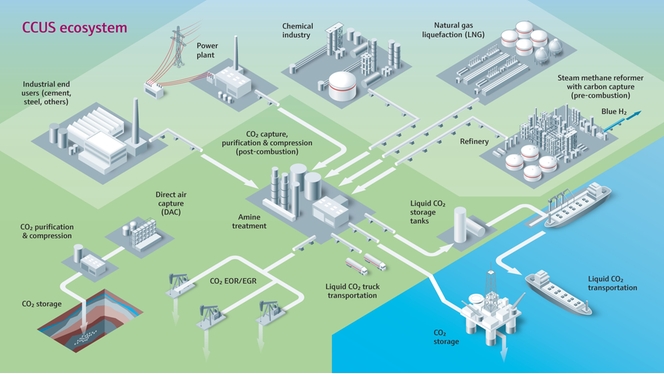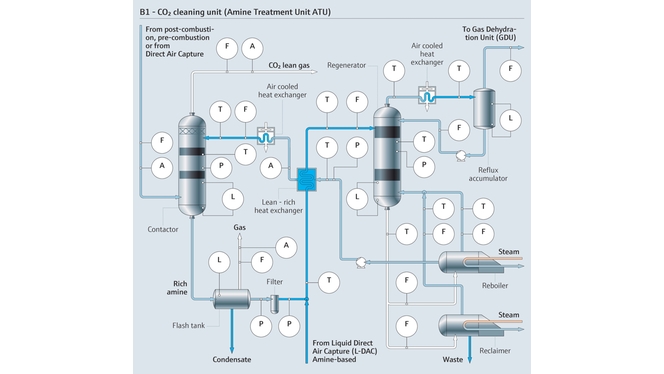One of the main enablers of the energy transition is the decarbonization of operations, value chain, and practices to mitigate the effects of climate change. An important driver is the adoption of carbon capture, utilization, and storage (CCUS) technologies to reduce CO2 emissions. Industry standards are still under development partially governed by regulatory compliance and government subsidies. Many decarbonization technologies have very specific requirements for process measurement equipment.
Key facts
321 Mt CO2
operational and planned annual capture capacity by 2030 (IEA)
The CCUS ecosystem in the Oil and Gas sector
Carbon capture, utilization and storage (CCUS) includes technologies that capture and make use of the high concentrations of CO₂ emitted by industrial activities. CCUS plays a key role in decarbonization and the challenge of global climate change. CO2 can be captured pre-combustion, post-combustion, or via DAC. Accurate quantity and quality measurements including safe data are crucial to optimize capture process, pipeline integrity, safe storage, environmental safety, and efficient operation.

Optimizing amine-based carbon capture processes
Carbon capture, utilization and storage (CCUS) is gaining more attention as a preferred solution to reduce carbon dioxide emissions from industrial plants. Chemical absorption based on amine solvents is considered one of the most mature technologies for carbon capture. Here, optimization of CO2 capture cost, as well as solvent management, are crucial for both the plant operator and the technology developer.
Our expertise in the field
Raman spectroscopy allows for accurate in-line process monitoring. The implementation of this technology can allow operators to reliably predict the total CO2 and amine concentrations in changing process conditions and minimize solvent loss through close monitoring of variations in quality.
Residual purified gas exiting the amine process can be measured for trace impurities such as H2S and CO2 using TDLAS technology.
By relying on the Endress+Hauser Raman Rxn4 process analyzer, you can:
- Replace off-line analysis, such as NMR or titration, with in-line monitoring and real-time information without human interference
- Measure performance of the absorber, regenerator, and reboiler
- Minimize carbon capture plant downtime
- Optimize overall plant operation decisions
- Reduce cost of operation by reducing amine losses
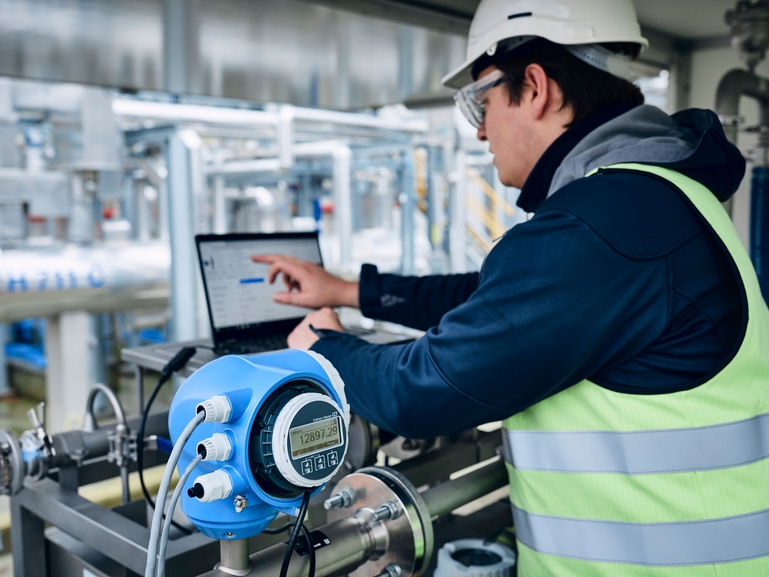
Flow metering solution for supercritical or dense phase CO2
Accurately measuring the flow rate of CO2 in a dense, supercritical phase is a key application in long-distance pipeline transportation. In this phase, the CO2 has a viscosity similar to that of a gas, but a density closer to that of a liquid, making its flow measurement a challenging task. Due to unusual variance in the thermophysical properties of CO2 in this dense phase, special care must be taken to maintain the temperature and pressure in the pipeline.
Our expertise in the field
From design to on-site installation, we have experience and expertise to execute these complex CO2 flow measurements while fulfilling regulatory quantity and quality parameters. Our project engineering centers around the world and fit-for-purpose portfolio of flow, pressure, temperature, and gas analyzers, ensure seamless project management and implementation.
- Coriolis mass flow meters offer reliable and proven technology for dense and supercritical phase CO2 measurement, ensuring highest accuracy and repeatability
- Complete metering skid suitable for continuous operation at high pressure, often in the range of 250 bar. This includes the complete pipework, pipe fittings, valves and other associated process equipment being rated to ASME CL 2500
- Design in accordance with recommended custody transfer standards and approvals, right selection of wetted part
- Laser based analyzer (TDLAS) to ensure the quality of CO2 by measuring impurities
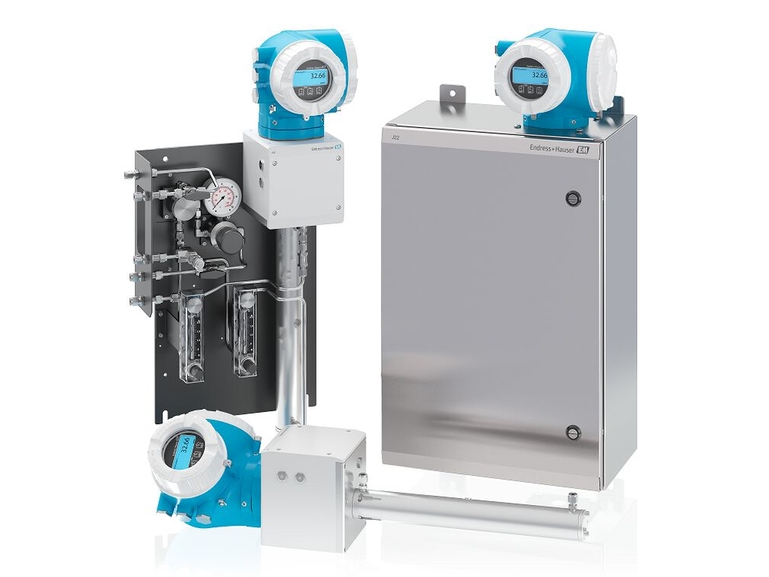
Moisture measurement in CO2 to ensure quality compliance
CO2 can be stored underground (sequestration) or used for Enhanced Oil Recovery (EOR) and other industrial purposes (e.g. synthetic fuels). Before pipeline injection, the CO2 must be dehydrated to avoid corrosion and ice/hydrate formation. After dehydration, the gaseous CO2 is compressed and liquefied for transport. Accurate moisture measurement optimizes dryer efficiency to ensure the CO2 meets proper specifications agreed upon by the supplier and the transport vendor.
Our expertise in the field
With a large installed base for moisture analyzers in high-concentration CO2 streams, Endress+Hauser has significant experience in providing gas analyzer technologies to ensure the quality of carbon dioxide. With our J22 TDLAS laser-based gas analyzers, we offer a reliable standard option for the accurate measurement of moisture in CO2 while ensuring dehydration efficiency, uptime, and availability. Tunable diode laser absorption spectroscopy (TDLAS) means:
- Measurement updates every second, no field calibration, and very low maintenance
- Very reliable construction using solid state sensing elements, ensuring plant availability
- Easy to install and commission with health monitoring allows hands-off operation for years
- Simple in-field servicing of electronics, optics, and sample conditioning components to minimize downtime
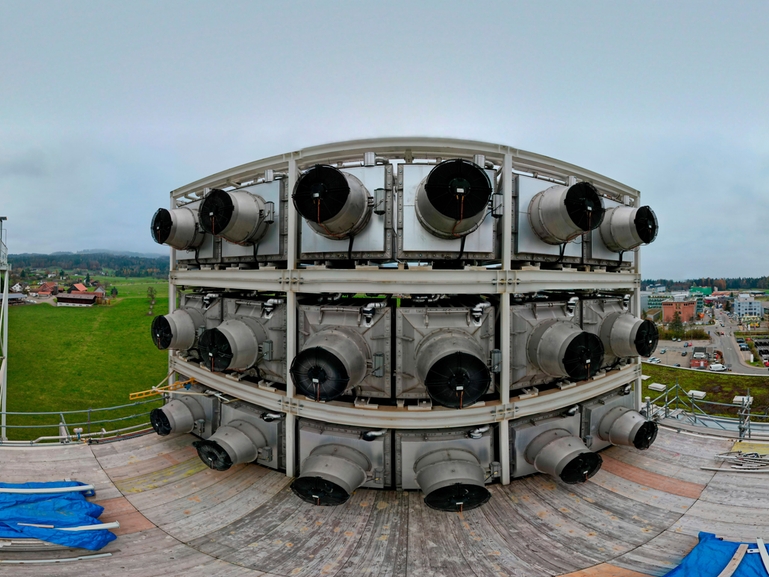
Instrumentation in direct air capture (DAC)
Unlike CO2 capture at the point of emission in heavy industries, direct air capture (DAC) extracts CO2 from the atmosphere, therefore helping to achieve the goal of net-zero emissions. Since the concentration of carbon dioxide in the atmosphere is significantly lower compared to CO2 coming from traditional flue gas, the process is energy-intensive and requires long-term investments. Additionally, the CO2 separation process is challenging.
Our expertise in the field
The high-concentration CO2 captured is further treated and either stored in geological formations, utilized to produce synthetic fuels, or used as feedstock. Its quality must therefore be closely monitored. Benefits from using Endress+Hauser devices include improved process safety, control, and quality validation at key measurement points.
- Thermal Proline t-mass I 500 mass flowmeter ensures continuous monitoring of captured CO2 with a great turndown, enabling detection of depleted membranes
- Pressure measurement with the Cerabar PMC51B pressure transmitter and temperature measurement with the intrinsically safe temperature sensor TM131 across heat transfer and filter equipment allow the unit to operate at the highest efficiency
- Maintaining superior quality of heat transfer fluid is achieved through monitoring pH and conductivity with the digital pH Memosens CPS11E sensor and Condumax CLS15D conductivity sensor
- Best-in-class gas analyzers such as the J22 TDLAS moisture analyzer and OXY5500 oxygen
analyzer ensure the quality of the CO2
Benefits
CCUS technologies are vital for the Oil & Gas industry to minimize its environmental impact and move one step closer to achieving net-zero carbon emissions. Endress+Hauser helps to reduce carbon capture plant downtime and ensure safe operation. Raman spectroscopy is employed for real-time monitoring, reducing time and resources spending on offline analysis. TDLAS gas analyzers reliably measure impurities allowing for cost reduction when it comes to e.g. purification equipment such as dryers.
Key facts
Real-time data
Raman analyzers can help reliably predict the total CO2 and amine concentrations in changing process conditions
Key facts
Cost savings
Reduction of total costs of ownership and safety risks
Key facts
< 30 ppb
Reduced dryer downtime by moisture break-through detection at part-per-billion measurement levels
How we can help
CO2 needs to be captured, transported, stored in underground storage facilities, or used for Enhanced Oil Recovery (EOR) or other industrial purposes. Processes within the CCUS value chain demand the highest levels of measurement accuracy, reliability, and real-time monitoring. Measurement challenges include operation in harsh conditions while regulatory standards are still being developed. Teaming up with an experienced partner helps you achieve sustainability goals in this dynamic environment.
- Broad portfolio and expert support: high-performing measurement equipment from a single supplier and continuous support during the life cycle of the project development
- Improved safety, process control, and quality validation at key measurement points
- Unique in providing accurate and reliable quality, quantity, and composition measurement
- Easy installation and commissioning with health monitoring allowing for hands-off operation and the reduction of cost and downtime
- Taking predictive maintenance to the next level: Endress+Hauser Heartbeat Technology offers full instrument diagnostics, monitoring and verification, Netilion IIoT ecosystem unlocks the full potential of field instrumentation for highest efficiency


